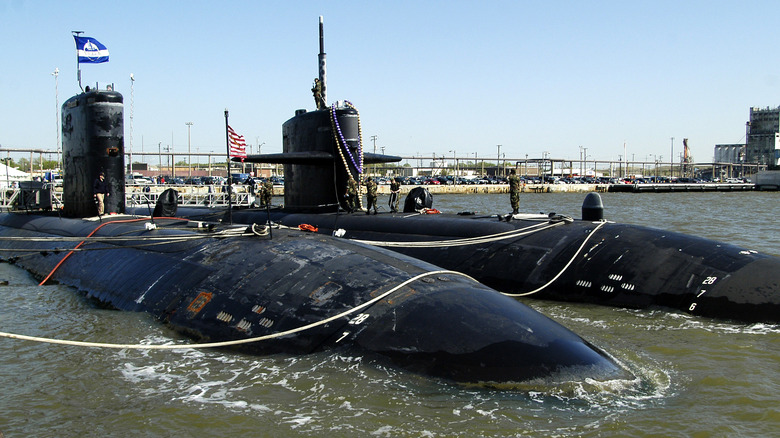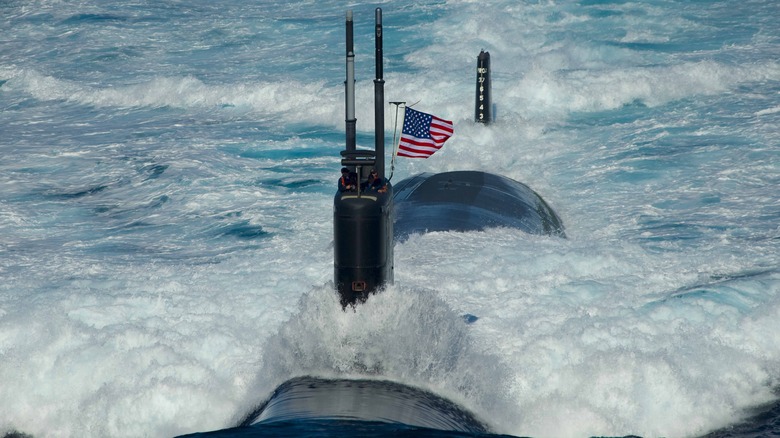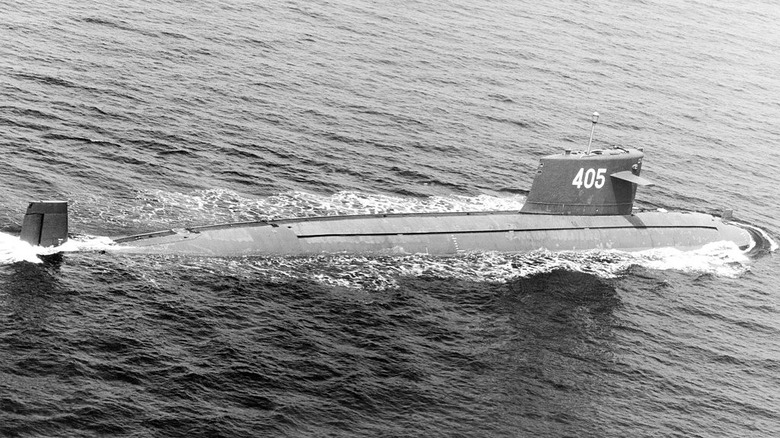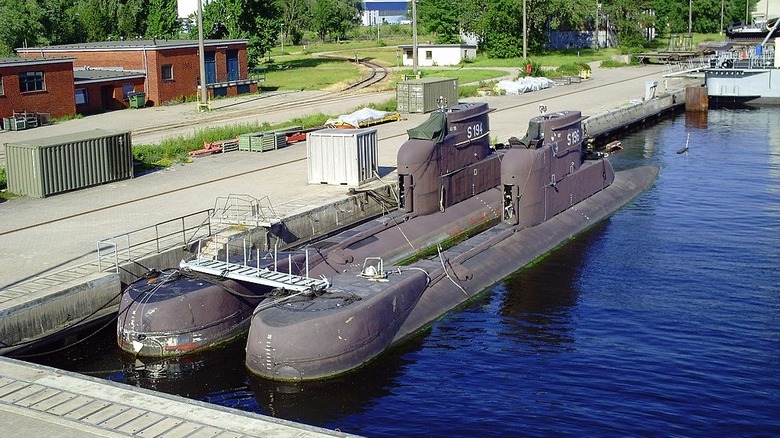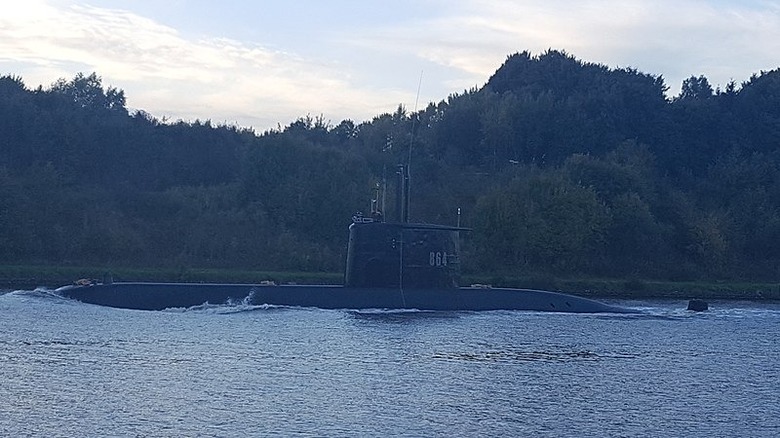10 Of The Oldest Military Submarines Still In Service Today
Submarines are one of the more sinister machines of war, with stealthy tactics and covert nature. While they first played a significant role in warfare during World War I, submarines were used with devastating consequences in World War II. Few could imagine the tension experienced by Allied mariners as they navigated busy Atlantic shipping lanes knowing a deadly U-Boat could strike at any moment. Likewise, it would be hard to describe the claustrophobia as a submariner waited in the stuffy hull, fathoms deep, knowing that a depth charger could eliminate them at any moment.
Much has changed since, as submarines have been modernized according to military requirements and new technologies. While they still perform the same clandestine functions, these larger vessels now use nuclear power in place of diesel-electric engines. Incredibly, these machines have an effectively infinite range, with recycled air and filtered seawater, and are only limited by supplies to feed their crew, or else they could potentially stay underwater indefinitely.
Despite remarkable leaps in technology and the reorganization of modern militaries, it may be surprising to know that some mid-to-late-20th-century vessels are still in service today, even playing crucial roles within certain nations' fleets. The following are the ten oldest military submarines that currently patrol the depths for training, reconnaissance, and combat purposes.
Oscar Class
Oscar class submarines, given the designation "Project 949" by the Russian military, were initially Soviet nuclear-powered vessels designed to combat NATO carriers with their fearsome 10.5-meter-long "Shipwreck" cruise missiles. They are used for missile attacks, and the armaments include torpedoes, anti-ship missiles, and SS-N-16 missiles with a 50-kilometer range.
The Oscar class nuclear submarine is simply colossal at 155 meters in length, and its characteristics are impressive. It has a displacement of over 16,000 tons, increasing to over 20,000 when submerged, it can last 120 days underwater, and it is tested to a depth of 600 meters. Such was its success that an improved Oscar II was announced with quieter engines and increased armaments. However, the original Oscar class had the capacity to carry nuclear warheads since removed under the requirements of the START treaty.
The Oscar class has been in service from 1980 to the present day, with 14 built, of which seven are out of commission. One of these, the infamous Kursk submarine, suffered two catastrophic explosions during a training exercise in 2000 and sank to the bottom of the Barents Sea, killing all 118 of its crew. This is the worst military submarine disaster in recent memory and cemented the Oscar class in the public conscience as a reminder of the dangers experienced by submariners, even in peacetime.
[Featured image via Wikimedia Commons | Cropped and scaled | Public domain]
Agosta Class
The Agosta class is a French diesel-electric submarine that has been in service since 1977. It is still used by the Navies of Pakistan and Spain, having been succeeded in France by the Scorpene and Rubis classes, and it was designed as a fast attack submarine, also known as a hunter-killer. These subs are designated for the sole purpose of stalking and sinking other military vessels, including other submarines.
An Agosta class submarine displaces over 1,500 tons when surfaced. It is armed with Exocet SM39 missiles launched from the torpedo tubes, which skim the sea's surface up to a range of 50 kilometers before striking their target with deadly computer-guided precision. It is also armed with torpedoes, including the formidable ECAN F17, which can strike up to a distance of 20 kilometers and a depth of 600 meters.
A later version, the Agosta 90-B, was created that was improved and automated, requiring a crew of 36 to operate, compared to 56 on the original Agosta class. This also has improved endurance, can dive deeper, is quieter, has updated systems, and has the addition of seaborne cruise missiles in its arsenal.
[Featured image by دانش خالد via Wikimedia Commons | Cropped and scaled | Public domain]
Los Angeles Class
The Los Angeles class is another fast attack submarine, built and operated by the U.S. Navy at around the same time as the Agosta class in 1976; however, unlike its French counterpart, this is a nuclear-powered vessel, making it vastly superior in its capabilities and performance.
With 62 built, of which 26 are still in active use, the Los Angeles class plays an important and dominant role, making up around one-half of the U.S. fast attack submarine fleet. Not only does it carry up to 25 torpedo-launched Tomahawk and Harpoon missiles, but it also has the capability to fire Tomahawks vertically via its 12 air-launching tubes. Its turret (or "sail") is strong enough to penetrate sea ice in arctic conditions, making it suitable for polar operations. It is powered by a pressurized water reactor which is incredibly efficient and powerful enough to propel it to over 25 knots (official speeds are censored).
Fans of Tom Clancy novels and films will recognize the Los Angeles class submarine as the exterior of the USS Dallas in "The Hunt for Red October," although the interiors were shot in a reconstructed film set (The "Red October" itself was a Russian Akula class sub). It is one of the more versatile submarine classes, with roles that include undersea and surface warfare, intelligence collection, aircraft carrier support, mine laying, delivery of special forces, and reconnaissance.
Type 035
In the 1950s, the Sino-Soviet pact broke down, and relations cooled between the communist states of China and the USSR. This led to a resurgence in Chinese military armament and a requirement for an updated submarine to replace its dated Romeo class unit. In 1969, work began on the Type 035 (also referred to as the Ming class for its NATO denomination), and it was delivered five years later in 1974.
This is a diesel-electric powered sub, consistent with many attack vessels of its size and era. It is equipped with a reinforced hull that enables it to dive to depths of 300 meters. Later redesigns added an extra propeller shaft, which improved its performance with an increased top speed. Early examples were armed with anti-ship missiles that could be launched while submerged and straight-runner torpedoes with a range of 5.6 kilometers, deployed via eight tubes.
A total of 23 Type 035 submarines were built. Many of these are the Type 035B Ming, which was released in the year 2000 and received an overhaul, making it more hydrodynamic and giving it updated armaments, including land attack cruise missiles and modern torpedoes. The Chinese and Bangladeshi armies still operate the Type 035, with one reported lost at sea as recently as 2003. As with the Kursk three years previously, this occurred during a training exercise, and all lives onboard were lost.
[Featured image via Wikimedia Commons | Cropped and scaled | Public domain]
Type 091
The development of the Type 091 (or Han class) began during the rule of China's Chairman Mao in the late 1950s, although the first was not to be launched for over two decades. It was intended to be a nuclear attack sub that could rival those of China's Cold War-era counterparts in the Soviet Union and the West. However, it was questionable as to whether it could equal them technologically at that time. In particular, it struggled to meet the same thermal performance standards and, crucially, sound reduction, as sonar detection is the biggest threat to a submarine's security.
However, on paper, the Type 091 was impressive at 98 meters in length, 10 meters in diameter, and with a top speed of 25 knots. Its pressurized water reactor was a triumph of Chinese engineering at the time, and advanced sonar, reconnaissance, and sound detection equipment were developed without any assistance from Western sources. For the aging Mao, it must have felt like a great swansong and a show of China's emerging status as a global power.
Five Type 091s were built, of which three are still in active use. These can fire various torpedoes (including NATO variants as the Chinese used standard calibers) and surface-launched anti-ship cruise missiles, with a range of 42 kilometers and a top speed of Mach 0.9. Despite their upgrades, these vessels have been reported to have required work to fix radiation leakage and are still considerably noisy, according to the U.S. Office of Naval Intelligence.
[Featured image via Wikimedia Commons | Cropped and scaled | Public domain]
Type 206
As another Cold War-era submarine, the West German Type 206 was a small-displacement vessel designed to patrol the Baltic Sea's shallow waters. This was at a time when the Soviet Union and several satellite states signed the Warsaw Pact, and the world was poised for international conflict. Typically for a small submarine, it was diesel-electric powered and notable for its stealth qualities that enabled it to operate far into enemy territories.
These stealth qualities were augmented by an anti-magnetic steel hull that would not attract mines and would confuse magnetic anomaly detectors. It was equipped with the latest in sonar technology, armed with 21-inch torpedoes and externally-carried mines, and it was agile enough to evade many threats, although it reached a top speed of just 17 knots when submerged. At just under 50 meters in length and with a displacement of 449 tons, this was one of the most compact military submarines of its era, and it has proved its value in over 50 years of operation, having been introduced in 1973.
Despite its usefulness, only 18 Type 206 submarines were built, of which just two remain in active service by the German Navy and the Columbian National Navy. However, the last vessels were modernized to include new periscopes, GPS navigation, updated armaments, and engine refurbishment, so we may have yet to see the last of these few remaining progressive and practical machines.
[Featured image by Tvabutzku1234 via Wikimedia Commons | Cropped and scaled | CC0]
Zwaardvis Class
During the 1970s, militaries were starting to see value in new submarine technology following the success of the USS Nautilus, the first nuclear-powered sub, in 1955. Having scrapped their plans to build a nuclear submarine due to budget constraints and U.S. intervention, the Royal Netherlands Navy opted to create a diesel-electric design based on the American Barbel class vessels. It shared the same teardrop profile and engine configuration as these and was spacious with its single-cylinder layout.
The Zwaardvis (meaning "Swordfish") class attack submarine has been operational since 1972. It has a length of approximately 67 meters and displaces around 2350 tons when surfaced. It houses 67 crew and features six tubes for its main armament of 20 torpedoes. Two boats served the Dutch Navy until the mid-1990s when they were decommissioned and broken up for scrap. However, two were sold to the Taiwanese government in the early 1980s and launched in 1986.
The Zwaardvis was renamed the Hai Lung class and underwent some modifications under its new role serving the Taiwanese Navy. Most notably, it was quieter and had modern surveillance technology to facilitate the task of deterring Chinese naval blockades. It also featured upgraded Mark 48 torpedoes to replace the aging Mark 37s as used on the Zwaardis. It is these two descendants of the original 1970s craft that are still in active service today.
[Featured image by Zatoichi1564 via Wikimedia Commons | Cropped and scaled | Public domain]
Type 209
In contrast to the Zwaardvis, with its somewhat limited production run, the German Type 209 has enjoyed a more successful career serving multiple navies worldwide. Out of the Cold War, when subterfuge, espionage, and consequently, submarine production was thriving, this diesel-electric vessel is highly versatile with flexible weapons payloads and serves a multitude of purposes, including special operation tasks, surveillance, information gathering, and sea control.
The Type 209 was built by Germany exclusively for export to other countries, and thanks to its run of almost constant orders over the years, builders Thyssenkrupp Marine Systems have been able to develop the Type 209 as technologies change and even customize it to suit specific tasks and requirements. However, the earliest model, launched in 1971, was 62 meters in length, displaced 1,450 tons, featured eight torpedo tubes, and was manned by 30 crew.
After World War II, Germany went on to become a prolific manufacturer of submarines, thanks in no small part to its Type 209 and subsequent exports. Somewhat impressively, the Type 209 is likely the most successful diesel-electric attack submarine ever produced, having been exported to over 15 countries, from Europe to the Mediterranean, North Africa, Asia, South America, and the Middle East.
[Featured image by Thomas M. Rösner via Wikimedia Commons | Cropped and scaled | CC BY-SA 2.0]
Victor Class
The Victor class nuclear-powered attack submarine has been in service since 1967. Originally given the designation "Project 671," it has been part of the backbone of the Russian Navy with the primary role of engaging and attacking U.S. ballistic missile submarines, and it has been produced in three variants, namely Victor I, Victor II, and Victor III.
Earlier versions of the Victor class had six torpedo tubes and could fire torpedoes and anti-submarine missiles and lay mines, whereas the later Victor III had an additional two torpedo tubes and updated weapons. This version caused a stir among NATO intelligence as it featured a large pod on its stern plane, which could not initially be identified. While it was later revealed as a towed sonar instrument, it was the cause of an incident during the Reagan administration, when a U.S Sturgeon class submarine collided with the Victor III while trying to photograph this device.
The Soviets were well behind their American rivals in terms of the acoustic engineering of their crafts. It wasn't until the creation of the Akula class and the subsequent Victor III that they began to achieve parity in this field, as the original Victor class was far noisier than its contemporary Sturgeon class vessel. Even so, with 48 built, and despite all but a few being decommissioned, this early nuclear submarine was one of the most prevalent ever produced by the Soviet and Russian militaries.
[Featured image via Wikimedia Commons | Cropped and scaled | Public domain]
Hai Shih Class
Many of us would hesitate before getting on an 80-year-old Ferris wheel, let alone a similarly-aged military submarine, and yet the Hai Shih class has been patrolling the waters of the Taiwan Strait for much of its long lifespan and is still in service as a training vessel for the Taiwanese Navy, much to the annoyance of its neighbor, China.
The last remaining 94-meter Hai Shih was originally the American USS Cutlass, a Tench class submarine launched in 1944 and sold to Taiwan in 1973, when it was renamed. Despite an expensive refit that should see it in service until 2026, there is no doubt that the ship, with serial number 791, is more than a little outdated, and yet U.S. researchers who recently toured the vessel described it as having a "high grade of operational condition."
While Hai Shih 791 is no longer combat-capable, in its day, it housed six bow-fired and four stern-fired torpedoes with 21-inch calibers. Nowadays, it plays a lesser role whereby it is used primarily to simulate an enemy vessel so that the Taiwanese Navy can practice anti-submarine tactics. While this may seem like a fall from grace for the World War Two-era diesel-electric submarine, the fact that it is still operational is a testament to this vessel's impressive build quality and design. If the lifespan of a submarine averages around 30-40 years, then the Hai Shih is a marvel of 20th-century engineering.
[Featured image by ROCN (Republic of China Navy) via Wikimedia Commons | Cropped and scaled | Public domain]
